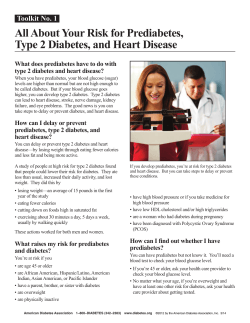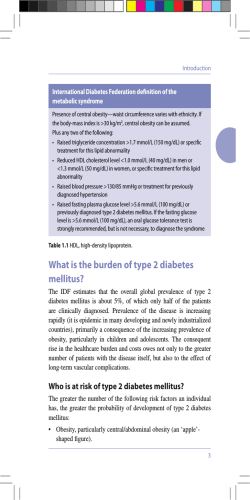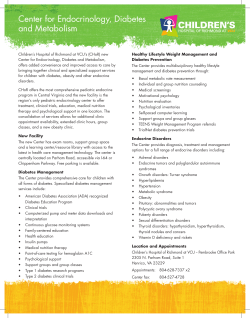
Country Guide – Norway (January 2012)
Country Guide – Norway (January 2012) Q. What preparation should I do prior to travel? A. While the amount of preparation required depends on the extent of travel, doing so is recommended since this will minimise any disruption or delay in the event of an emergency, and hopefully install confidence for future travel. Firstly, the destination should be investigated in full, considering aspects such as health and safety risks, local customs, currency, the location of medical centres, methods/routes of travel, food choices and customs regulations. Travel plans should also be discussed with your Doctor and Diabetes Educator. In addition to ensuring that you have all of the supplies required, they can provide advice on any changes to your individual medication and food routines that may be required, such as when crossing time-zones or following the development of illness such as diarrhoea and vomiting. If applicable, they can detail the most suitable methods of keeping insulin within recommended temperature ranges when access to a fridge is unavailable. A typed and signed letter from your Doctor explaining your medical condition, treatment and subsequent need to carry prescription items and diabetes related supplies (which should be individually detailed) should also be obtained, together with readable copies of prescriptions. Some doctors will charge for writing a letter, so if you plan to travel frequently it would be a good idea to ask for it to be phrased in such a way that it can be used more than once. Try to get a few copies. It should also be ensured that prescription labels on any medications are clearly printed and attached to the medication. The name of the patient, medication and prescribing doctor, together with their contact details, should also be both clear and easy to read. When travelling overseas, you are encouraged to register with the Department of Foreign Affairs and Trade. In the event of a need for contact, such as in a natural disaster, civil disturbance or a family issue, the information provided can speed up the relevant process. Registration can be done either on-line at www.smarttraveller.gov.au or in person at any Australian Embassy, High Commission or Consulate. Consular assistance can be obtained by telephoning the Department of Foreign Affairs and Trade on 1300 555 135 (if calling from within Australia) or +61 2 6261 3305 (if calling from overseas). The following websites may also be of use: www.dfat.gov.au www.idf.org www.iamat.org Q. Will I need to have any vaccinations to travel to Norway? A. You will need to discuss this with your Doctor or travel clinic as they will be the best source of information about preventative measures, immunisations and outbreaks of disease overseas. The following websites may also be of use in obtaining background information: www.cdc.gov/travel www.smarttraveller.gov.au www.health.gov.au www.iamat.org Q. Will I need to order a ‘diabetic meal’ for the aircraft? A. This is not entirely necessary, although you may still choose to. In general, many ‘diabetic meals’ served in-flight can be quite bland. They may also be too low in carbohydrate or energy to meet your needs and thus either a standard meal or one which is low in saturated fat may be more appropriate. If applicable, it is recommended that you carry your own supply of portable carbohydrates in case of any unexpected hypoglycaemia, meal delays or if you dislike the meal offered. Importantly, you may decide to tell a flight attendant at the start of your trip that you have diabetes so that your needs are catered for. Take care to drink plenty of water throughout the flight, not just at meal times, to stay hydrated. Q. Is there anything else that I should consider in-relation to the flight? A. Yes. Try to avoid alcohol, wear comfortable shoes and exercise your feet regularly to help prevent swelling. Moving around the cabin as often as you can by walking up and down the aisle can also help with your circulation and managing your blood glucose levels. Bear in mind, the anticipation/stress of a trip, together with differences in activity, routines and food may affect your blood glucose levels so you may need to check more often. Q. Will my insulin be damaged by the security x-ray? A. It is considered unlikely that insulin would be harmed by exposure to x-rays in security equipment. However, if you are concerned, you may ask airport security staff to physically check your supplies. Please be mindful that you are aware of the location of your supplies at all times since if they have been placed in a bag, for example, and you are delayed for whatever reason whilst it is being x-rayed, they may be at risk of being accidentally collected by another passenger or stolen. However, when considering insulin pumps, due to concerns surrounding the potential for xray machines and scanning wands to delete related data, the safest method is to again ask airport security staff to physically check this. Please also refer to: www.medtronic-diabetes.com.au/security.html Q. Can I bring my supplies onto the aircraft? A. People with diabetes can still bring related supplies with them onto aircrafts despite increased security restrictions. A typed and signed letter from your doctor (as aforementioned), together with photographic identification (where requested), should be presented to both airline and security staff. Diabetes supplies should be carried as hand-luggage and not be put in the plane’s hold. This is because not only may they go missing, as happens from time to time, but the temperature under which such baggage is subjected to may, where applicable, go outside the recommended ranges as provided by the manufacturer. Subsequently, this can cause damage. Those travelling may wish to contact their airline in advance for more up-to-date information. Q. Where should I pack my diabetes supplies and insulin when overseas? A. These should be distributed amongst your luggage and, where applicable, travelling companions. This is in case any item of luggage becomes either accidentally mislaid or stolen. Q. What medical services will be available to me as an Australian citizen? A. Australia has a reciprocal health agreement with Norway. Please refer to: www.medicareaustralia.gov.au/public/migrants/travelling/norway.jsp It is strongly recommended that prior to departure, comprehensive travel insurance that will cover any overseas medical costs is taken out for the whole time that you are away. Before making a choice, you should read the policy document in detail and confirm that cover is not excluded for any existing medical conditions (i.e. diabetes). It is also worthwhile to check policy excesses and whether there are any circumstances or activities for which cover is not included. Please note that the cost of obtaining on-going diabetes related supplies is often not covered. Since there are numerous insurance policies available, suited to individual needs, we advise that you research the market extensively. Q. Should I carry diabetes identification on me, outlining that I have diabetes? A. Yes, at all times. Besides the aforementioned typed and signed letter from your doctor outlining both your medical condition, prescription items and diabetes related supplies (which should be individually detailed), together with copies of prescriptions, other forms of identification can include a National Diabetes Services Scheme (NDSS) or Medicare card, jewellery such as a MedicAlert or SOS bracelet, or standard diabetes identity cards. Identification will help to speed-up treatment in the event of any ill-health. It is also worthwhile to carry written details of your next of kin or a significant other who would be able to advise details of yourself in the event of ill-health or an emergency. Q. Will I be able to obtain my medication overseas in case of an emergency? A. If you treat your diabetes with medication, you should contact the relevant manufacturer prior to departure to see if it is supplied in Norway, whether it comes in the same strength and whether it is sold under the same name. Where applicable, it is also worth checking whether the administering device is available. Contact details are given below for the manufacturers/suppliers of human insulin, based in Australia: Eli Lilly Pty. Ltd., 112 Wharf Road, West Ryde, NSW. 2114 Telephone: 02 9325 4444 Novo Nordisk, Level 3/21 Solent Circuit, Baulkham Hills, NSW. 2153 Telephone: 1800 668 626 Sanofi Aventis, Talavera Corp. Centre, D/12-24 Talavera Road, Macquarie Park, NSW. 2113 Telephone: 02 8666 2200 Please note that contact details for the manufacturers of diabetes tablets have not been detailed here because each individual type of tablet is often made and distributed by various companies, and is therefore beyond the scope of this guide. It is also due to this scope that details surrounding incretin mimetics have also not been provided. Where possible, always plan to bring more medication than will be required. Q. Will I be able to obtain blood and urine glucose testing equipment? A. Yes, but you should contact the manufacturer of your personal blood and urine testing supplies prior to departure to see if it is supplied in Norway. Contact details are given below for a few of the manufacturers in Australia: Abbott Diabetes Care, 666 Doncaster Road, Doncaster, VIC. 3108 Telephone: 1800 801 478 Bayer Australia Ltd., P.O. Box 903, 875 Pacific Highway, Pymble, NSW. 2073 Telephone: 02 9391 6000 Roche, 31 Victoria Avenue, Castle Hill, NSW. 2154 Telephone: 02 9860 2222 Where possible, always plan to bring more testing supplies than will be required. It may be beneficial to also carry visual blood testing strips if not already utilised to obtain readings in the event of either meter damage or loss of battery power. Q. Will I be able to obtain insulin pump consumables? A. You should contact the manufacturer of your personal insulin pump consumables prior to departure to see if they are supplied in Norway. Contact details are given below for a few of the manufacturers in Australia: Australasian Medical and Scientific Ltd, Unit 2, 19-21 Gibbes Street, Chatswood, NSW. 2067 Telephone: 02 9882 3666 Medtronic Australasia Pty Ltd, 97 Waterloo Road, North Ryde, NSW. 2113 Telephone: 1800 668 670 Roche, 31 Victoria Avenue, Castle Hill, NSW. 2154 Telephone: 02 9860 2222 Where possible, always plan to bring more consumables than will be required. Q. Are the blood glucose levels measured in mmol/L (as in Australia) or mg/dL? A. mmol/L. Q. What is the emergency services (medical) telephone number? A. 113. Q. What are the main languages spoken? A. Norwegian (see end of guide for some useful translations) and English. Q. How will I be able to make food choices? A. As with all overseas travel, care should be taken when making food and drink choices. It is important to note that where local tap water is not safe, bottled water should be consumed. Always check the seal to ensure it is unbroken and where tap water in not considered safe, avoid ice and ice based drinks, and use bottled water to brush your teeth. Also be cautious of uncooked food (including salads) and fruit that cannot be peeled. Sometimes when in a foreign country, going to a supermarket is a good way to work out what sort of food is available. If they don’t speak your language you may recognise foods from home and work out what they are called in the country you are in. If you are travelling with a group ask your tour leader to help you get the food you need. They will usually speak the language of the country you are in and be able to speak to the waiters or chef in restaurants you go to as a group and give you an idea of what to ask for/ say if you are eating independently. If applicable, it is recommended that you carry (at all times) some form of easily absorbed carbohydrate such as juice or jelly beans in case of a hypoglycaemic episode, and extra carbohydrate for follow-up treatment. Q. What are the staple starchy foods I can expect in Norway? A. Potatoes, bread, rice, cereals, pulses and pasta. Q. What foods should I be cautious of? A. Norwegian cuisine is known for its salt and sugar curing of fish and meats, such as gravlaks (salmon) and gravet elg (moose). Be mindful of your portion size to avoid excess salt and added sugars in your diet. Take care to limit foods high in fat, such as fried foods, sausages, fatty meats, mayonnaise, cream sauces and sour cream. Q. Does Norway have a Diabetes Association that I might be able to contact during my visit? A. Yes. Contact details are: Norges Diabetesforbund, Østenjøveien 29, PO Box 6442, Etterstad, Oslo 0605 Telephone: +47 2305 1800 Website: www.diabetes.no Q. Does Norway have an Australian Embassy that I might be able to contact during my visit? A. No. However, Australia has a Consulate in Norway. Contact details are: Australian Consulate, Wilh. Wilhelmsen ASA, Strandvn 20, Lysaker, Oslo Telephone: +47 6758 4848 Website: www.denmark.embassy.gov.au/cpgndansk/home.html * The Australian Embassy in Denmark has non-resident accreditation to Norway. If you would like further information on any aspect of this country guide or diabetes in general, please do not hesitate to contact us. Some information in this country guide has been reproduced with the kind permission of Diabetes UK. Although we have endeavoured to check all of the content, Australian Diabetes Council or Diabetes UK cannot be held responsible/liable for any inaccuracies. Translations – Norwegian 1. Is there anyone who can speak English? Snakker noen Engelsk? 2. I have / he has / she has diabetes. Jeg / han / hun har diabetes. 3. I / he / she need(s) to see a doctor urgently. Jeg / han / hun trenger øyeblikkelig legehjelp. 4. Please give me the address of the nearest doctor / hospital. Kan du gi meg adressen til nærmeste legekontor / sykehus. 5. This person is having a ‘hypo’ / hypoglycaemic episode. Denne personen har føling / hypoglykemi. 6. This person is on insulin treatment. He / she has ... injections a day of ... insulin. The dosage is ... units. Denne personen Er på insulin behandling. Han / hur har ... injeksjoner om dagen av ... insulin. Dosen er ... 7. Is on tablet treatment. He / she takes ... Er på tabelett behandling. Han / hun tar ... 8. I have lost / broken my insulin / tablets / needles / pens / syringes / blood glucose monitor / lancets / blood glucose testing strips / Identification disc. Jeg har mistet / ødelagt min(e) insulin / tabeletter / nåler / penner / sprøyter / blodsukkermåler / lansett / blodsukker teststrimler / identifikasjons kort. 9. Please give me a prescription for insulin / needles / syringes / tablets / blood glucose testing strips / lancets. Ver så snill å gi meg en resept på insulin / nåler / sprøyter / tabeletter / blodsukker testrimler / lansetter. 10. Where is the nearest pharmacy? Hvor er nærmeste apotek? 11. Have you any sugar free drinks? Har du sukkerfri drikke? 12. Do you have any artificial sweeteners? Har du noen kunstige søtnings midler? 13. Would it be possible to keep this ice pack in your freezer for keeping my medicines cool? Er det mulig å oppbevare denne isposen I fryseren slik at mine medisiner kan bevares kaldt? 14. This is a blood glucose meter that I need for monitoring my diabetes. Dette er blodsukker måte apparat som jeg trenger til å overvåke min diabetes.
© Copyright 2025









![[ PDF ] - journal of evidence based medicine and](http://cdn1.abcdocz.com/store/data/000659661_1-a8a263e2df487f2ae71e95df10b59030-250x500.png)











